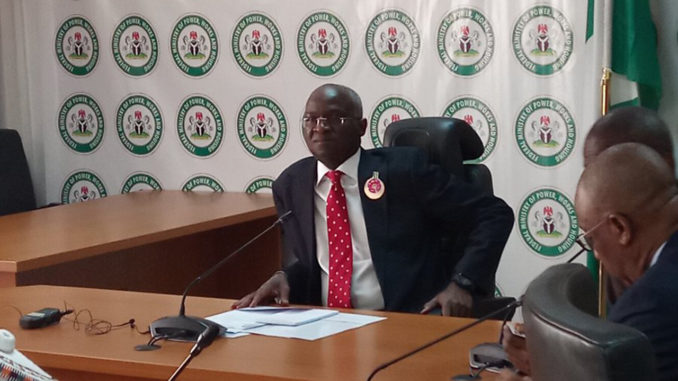
Reports that N110 billion losses were incurred in the first three months of 2019, arising from multiple hitches, highlight the unending chaos in Nigeria’s power sector and the imperative of transformation. A report on cumulative losses to the system due to insufficient gas supply and tumbledown distribution and transmission facilities in the first few weeks of this year demonstrates the failure of the 2013 privatisation process to deliver improvements. President Muhammadu Buhari must act creatively to deliver adequate power to realise the dream of sustained economic recovery.
Electricity is a major driver of economic development, “the lifeblood of many activities” that underpin production and investment. Unlike other countries, Nigeria’s policymakers only pay lip service to it. Neglect, corruption and mismanagement culminated in the fraudulent power sector privatisations, whose fifth anniversary most Nigerians celebrated in darkness and businesses in despair.
The misery saw N108.65 billion down the drain between January and mid-March, according to data from the Advisory Power Team domiciled in the Office of the Vice President. Citing low water reserves, insufficient gas for the power stations and decrepit transmission and distribution infrastructure, the report said 2,978 megawatts did not get to the national power grid at all within the period. It is either the generating companies are unable to produce enough, or what they produce cannot be wheeled by the sole transmission utility, due again to inability of distribution companies to absorb what is on offer, or when the national grid suffers one of its frequent system collapses. These resulted in N41.4 billion in lost revenues in January 2019, N44.4 billion in February, N1.7 billion on March 9 and N1.51 billion on March 11. Some N69.1 billion was lost in the first seven weeks of this year. Between January and November 20, 2018, the Ministry of Power, Works and Housing, put sector-wide losses at N475.32 billion. Stakeholders warned that the sector could collapse in the face of an estimated N4 trillion in debts and losses.
Today’s crisis is one foretold: following the Electric Power Sector Reform Act 2005, its culmination; effective privatisation of the 17 of the 18 companies unbundled from the state-owned power monopoly, held the key to a restructured power sector that would attract private investment, raise generation, distribution and transmission infrastructure and output, as well as propel industrial take-off. But this proved a forlorn promise as the government that oversaw the asset sell-offs was not motivated by national interest, but did so to favour cronies and narrow interests that were complete strangers to the power industry. Having crowded out global players, there has been little investment by the buyers, who mostly lack the financial strength, technical or managerial expertise to run power assets. They also lack name-recognition or track record. The government’s ambition to attract $1 trillion investments to the sector by 2030 looks more unrealistic by the day. Credited with the first radical reform of its power sector, Chile earned $1.2 billion from selling some power assets 1985-89 and has seen vast improvements just like Argentina, says a World Bank report.
While the organised private sector reckons that a minimum of 22,000 megawatts is needed today, total installed generating capacity from all sources is 12,910MW, according to official records, but available capacity is 7,652MW, while transmission wheeling capacity is 8,100MW. But the problems begin at the generation point as thermal power, at 82 per cent of all power stations, faces severe gas supply hiccups – from inadequate supply to vandalism of pipelines. Wheeling the generated power through the national transmission power grid is beset by limited capacity and system collapse caused by inability of the DisCos to take power. Transmission Company of Nigeria’s CEO, Usman Mohammed, explains that because the DisCos are not investing in new equipment or upgrades, their wobbly machinery damages TRANSYCO’s equipment, citing a recent collapse of five transformers at a loss of $10 million.
Buhari and the Minister of Power, Babatunde Fashola, have wasted almost four years trying vainly to manage the monumental mess they inherited. But only a radical new approach can upturn the current gridlock, evict the incompetent groups and attract genuine global players who can mobilise the necessary capital, expertise and technology to the sector to unleash the full productive potential of Africa’s biggest economy.
The government should carefully scrutinise the legal arrangements it made with the emergency consortia it sold the GenCos and DisCos to, exploring the opportunity of the mandatory performance review due after the first five years of the asset transfer. The current operators of the 11 DisCos, the weakest link in the chain, clearly lack resources to invest in facilities and are insufferably inefficient. Though expected to provide 1.64 million pre-paid meters to customers by December 2018, 4.78 million customers out of the total 8.34 million had none and are subjected to the tyranny of “estimated billing.”
Selling its own 40 per cent stake in the DisCos and persuading the other investors to follow suit in favour of established first rate operators should be government’s priority. What is needed are the strong political will, an urgency to deliver and the realisation that without improvement in power, the economy will continue to deliver poverty.
Efforts should be concentrated on stepping up diversification from gas-powered plants to alternative energy sources like solar, wind, coal and biomass/waste, water. Australia’s federal and state governments have been overcoming the hitches that accompanied power sector privatisations of the 1990s by driving and competing for investments in wind and solar energy. By December 2017, the country had 79 wind farms with combined 4,455MW and a further 18,823MW proposed; solar powered plants had combined output of 7.024MW.
State governments should take advantage of the new rules allowing generation, regional and mini distribution networks. Government should cut through the legal and technical maze of the electricity power sector and shake it up now.
END

Be the first to comment